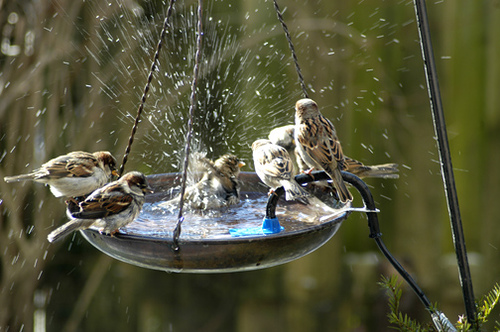Inviting Birds to your Garden

As the winter season approaches (yes it’s coming) we will see our feathered will fly south but many will stay through the cold winter months. They will appreciate the occasional snack from a feeder placed strategically in your garden but just as important are other needs such as water and shelter. Here are some tips to ensure avian success.
Trees and shrubs have a lot of different values – as nesting sites, insect (food) hiding places and shelter from weather and predators. To encourage a wider variety of birds to visit your garden patch you can introduce a variety of different cover. Many of which will double as food sources in warmer months.
Cherry Trees
Plant ornamental or choke cherries if you don’t want to share as the birds will eat the cherries.
Mountain ash
The brilliantly coloured berries of mountain ash are eagerly devoured by robins, cedar waxwings and other birds. The berries will persist into the fall and winter
Russian olive
Fragrant yellow flowers for gardeners and fruit for the birds.
White birch
Seeds on this tree stay all winter and are especially desired by birds like goldfinches.
Maple & Oak
Attract orioles and tanagers as these birds prefer the safety of a high canopy – assuming of course it IS a high canopy, you may need to wait for the tree to grow.
Conifers & Evergreens
The dense foliage of spruce, pine, fir, larch and hemlock provide secure nesting sites for many birds and an ample supply of seeds from their varied cones.
Shrubs Fruiting & Floral
There’s also a wide variety of easy to grow shrubs that attract birds. Small fruit, such as currants, raspberries, blueberries blackberries and gooseberries will certainly attract birds. Keep in mind though you will need to net anything you do not want to share as they will eat all of the fruit if provided the opportunity. Even many ornamental shrubs, there are many with choice fruit. The dark mature fruit of the following popular garden shrubs provide food sources to many birds: flowering currant, bush honeysuckle, rugosa rose, red leaf rose, all dogwoods, serviceberry, privet, coralberry, snowberry, elderberry and autumn olive.
Grasses and Naturalized Areas
If you have a large enough landscape you can provide a “wild” spot in your garden for tall grasses, thistles, goldenrod and ragweed. If you have a more cultivated aesthetic, ornamental grasses can be used, leaving them to stand into the winter with their supply of seeds. So too, with many annual and perennial plants, which we normally remove or cut down in the fall; if left in place, they provide abundant seed for birds in winter.
Water
If your property does not include a pond or stream, providing water in a birdbath, fountain or large saucer will bring birds to your garden and keep them coming back. Use a heater and bubbler to keep water moving and thawed during winter.
Bird feeders
The larger the menu you offer, the more types of birds you will attract. Try bread crumbs, dried fruit, suet, cracked corn and sunflower seeds. The type of feeder will also dictate what type of birds you will receive as guests.
No matter your efforts, the reward is ten fold as the birds add a new dimension to your landscape with their colour and sounds

